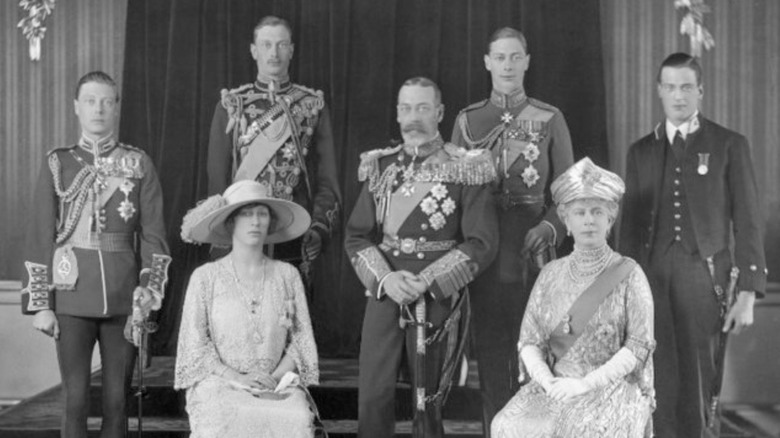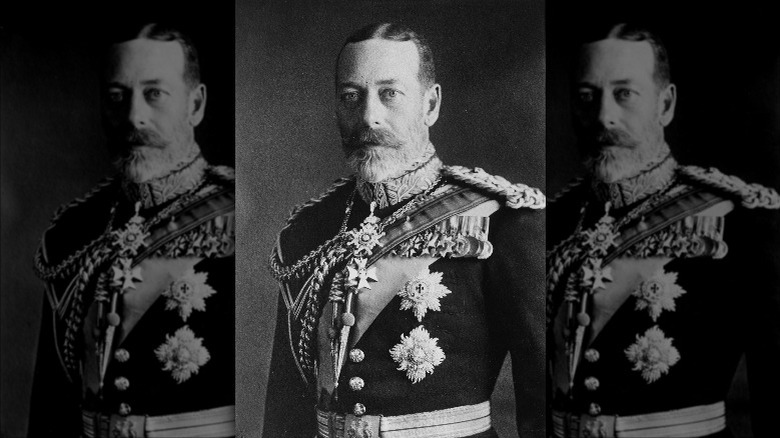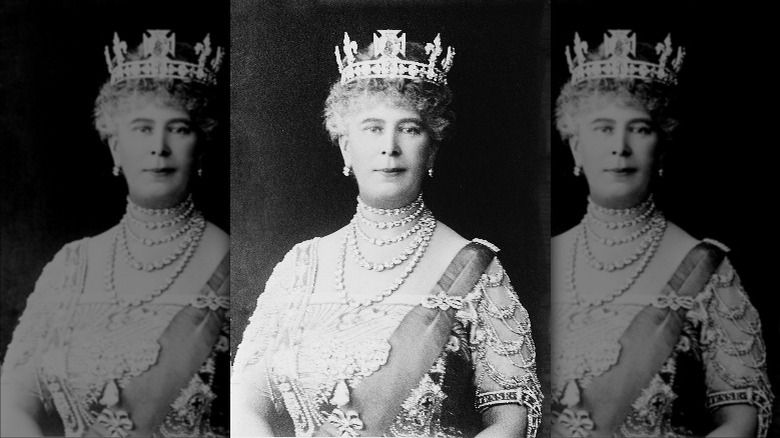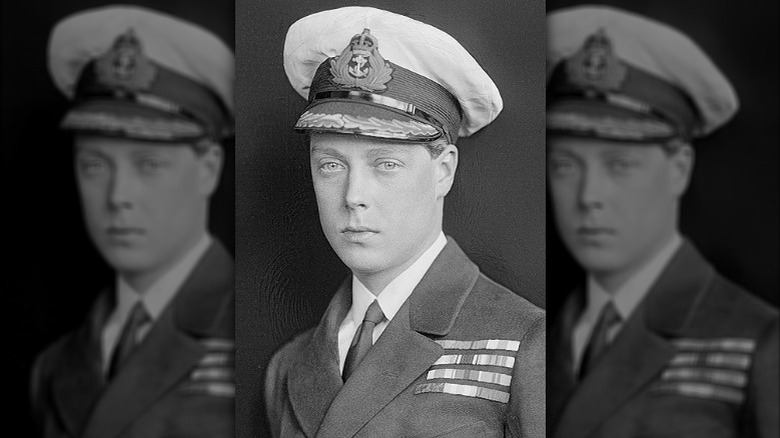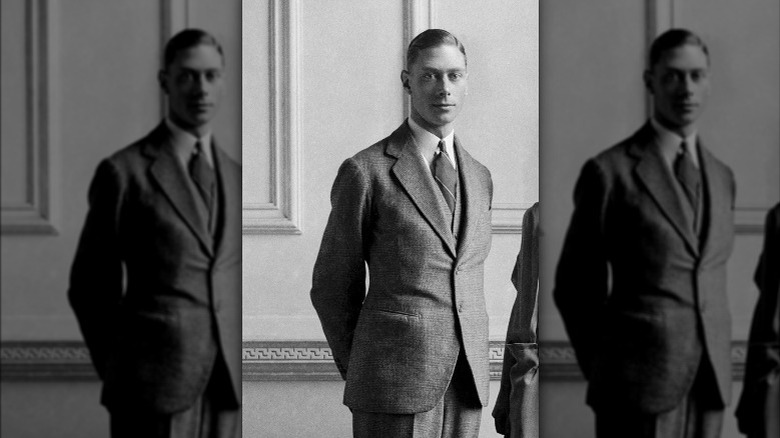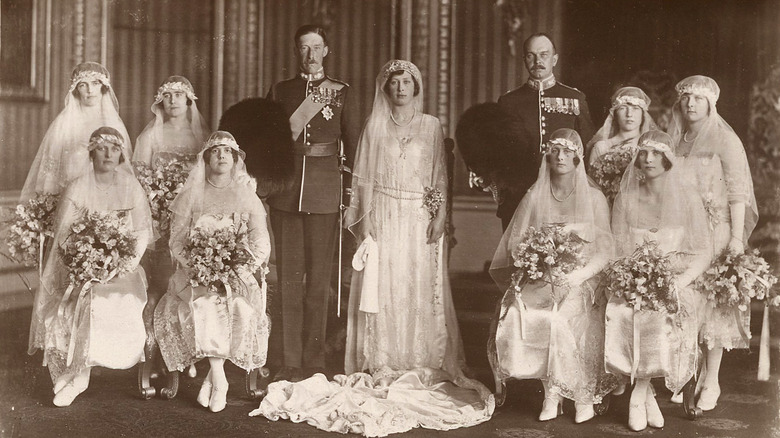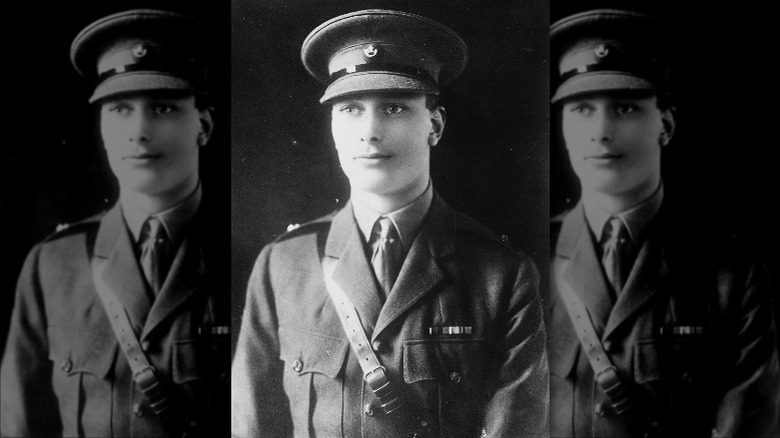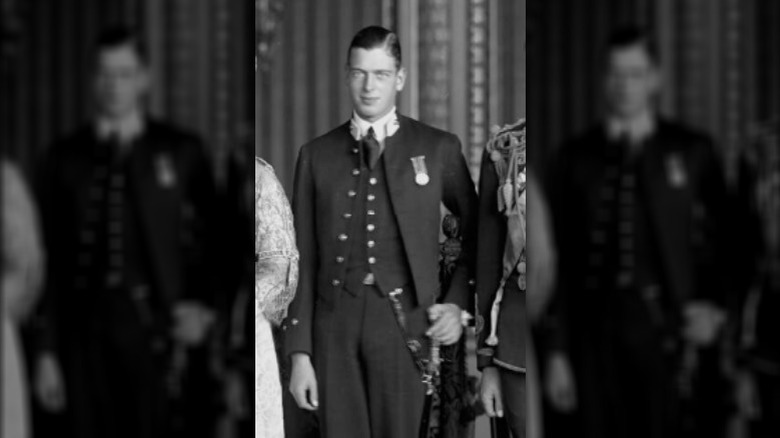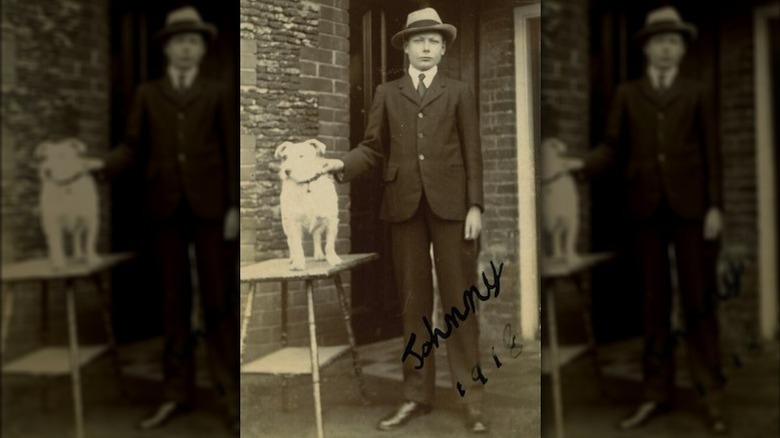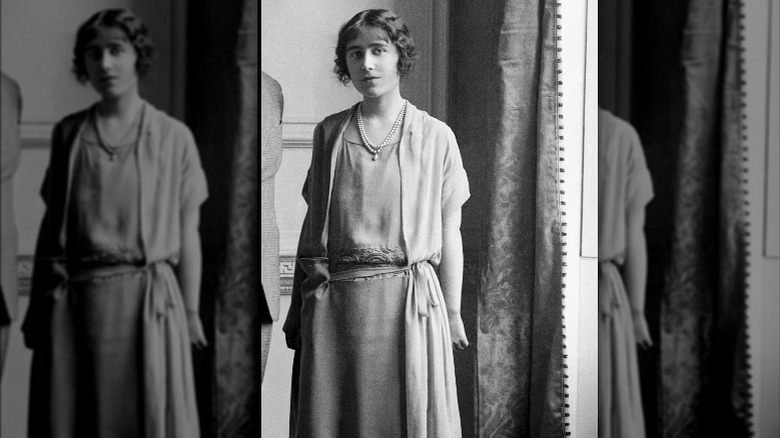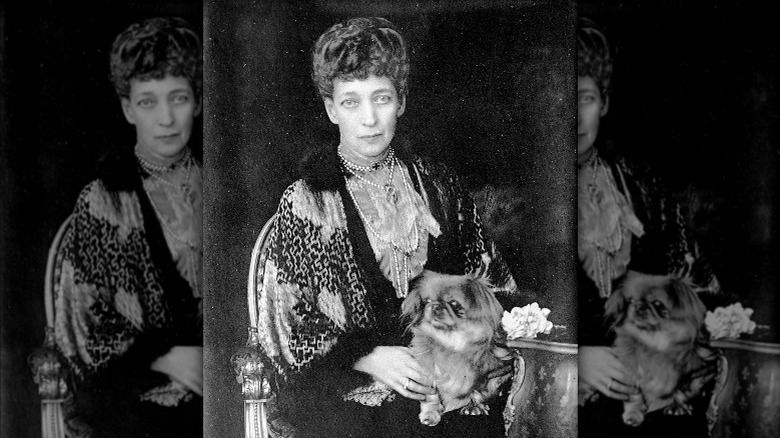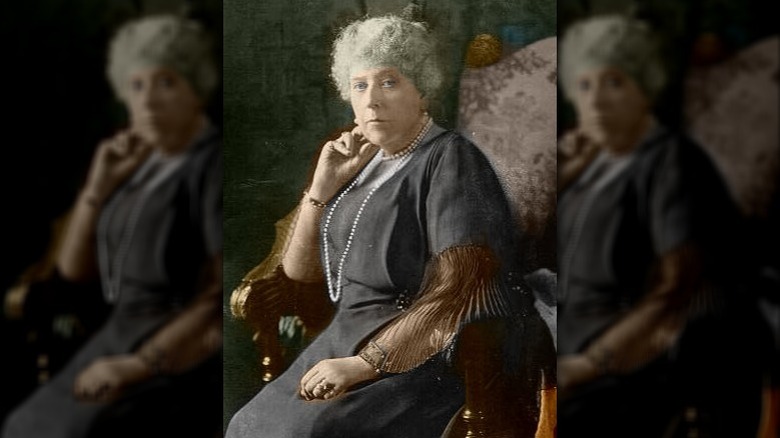What The Royal Family Looked Like 100 Years Ago
These days, the British royal family is known around the world. Even if you don't care about them in the slightest and are a diehard republican (small "r," the kind that want to end the monarchy), you would probably be able to pick Queen Elizabeth II or Kate Middleton (a.k.a. HRH Catherine, Duchess of Cambridge) out of a lineup. Even when you go back a few decades, Princess Diana was probably the most recognizable woman on Earth for a good 15 years at least.
But when you start going back much further than that, especially before the current queen took the throne in 1952, things get a bit hazier. How many people know that there was a George V, let alone what he looked like? Sure, people at the time would have recognized the major royal figures, but a century later, none of those members of the House of Windsor really seared themselves into the collective historical memory. The history buffs and royalty stans might be aware of the royal family circa 1920, but the average person off the street would have no clue.
Let's fix that. The royal family of 100 years ago was a fascinating mix of old school regal figures and bright young things ready to party through the Roaring Twenties. There were scandals, tragic deaths, and a kleptomaniac. This is what the British royal family looked like 100 years ago.
George V
George V was a king firmly tied to the Victorian era but leading his country into a very different new century. Ascending to the throne when his father Edward VII died in 1910, per Biography, George reigned during the First World War, which, incidentally, was fought against and with a couple of his first cousins, including Kaiser Wilhelm II of Germany. Another first cousin, Nicholas II of Russia, who was assassinated along with his family in 1918, looked like George's twin. In some photos, it's very hard to know which one of them you are looking at.
George V had served in the Royal Navy for 15 years when he was young, according to BBC News, and he loved wearing uniforms, naval or otherwise. And in 1920, the Navy made the big mistake of changing a small detail of their uniform without asking the king (because ... why would they?). The gold lace stripes worn on the cuffs of an admiral that denotes one's rank were made slightly thinner. That was it. But George was not having it, refused to wear the new stripes, and made sure no one in the royal family did either, something that holds to this day. If you ever see one of the current royals in an admiral uniform, they will have thicker stripes than anyone else.
The king definitely gives off a serious vibe in this portrait, taken in 1923. He was 58 years old and would live until 1936.
Queen Mary
Princess Victoria Mary of Teck, called "May" by this nickname-happy family, married the future George V in 1893. According to Vanity Fair, the year before, she was engaged to his older brother Prince Albert Victor ("Eddy"), but then he died. And like any normal family, the decision was made to treat Mary like a hand-me-down and have her marry the next brother in line, George.
Mary was smart – smarter than her husband – but they were both relatively reserved. "She did look austere," historian Hugo Vickers explained. "Underneath it all, she had a good sense of humor, but she was quite shy." But she did not let her shyness keep her from doing the events required of the royal family. The New York Times reports that during WWI, a younger royal complained they were tired and hated visiting hospitals. Mary informed her relative, ”You are a member of the British royal family. We are never tired and we all love hospitals.”
Mary's shopping trips were considered events. One biography says, "Crowds followed her; whatever she was seen wearing or buying would swiftly be in such demand that manufacturers would increase production." But she also liked to take things from shops without paying for them. She was an almost pathological collector, and it didn't matter if it was a friend's possession or an item on display in a museum, if Mary liked it, she asked for it ... or just took it. And obviously more was more, considering her look for this 1923 portrait.
Edward, Prince of Wales
In the 1920s, the Prince of Wales was George V's eldest son, whom the family called David. However, he would go down in history as Edward VIII, the king who abdicated the throne to marry the twice-divorced American Wallis Simpson. After the abdication, he was known as the Duke of Windsor. To avoid confusion, let's just call him Edward.
Edward was perhaps one of the most fashionable members of the royal family ever. One thing that comes through in contemporaries' comments about him is how slick he was. According to Biography, an obsessed American press called him an "arbiter of men's fashions, a fearless horseman, tireless dancer, idol of bachelors, dream of spinsters." Biographer Alexander Larman, author of "The Crown in Crisis: Countdown to the Abdication," explains (via Vanity Fair) that Edward was "an accomplished public speaker who seemed genuinely to enjoy the adulation of the crowds and the masses." It wasn't all good though, as Larman adds, "Edward was a consummate performer whose charm, charisma, and good looks could not disguise the vacancy at his core." And Gore Vidal once wrote that Edward "always had something of ... riveting stupidity to say on any subject."
But Edward was a ladies man, carrying on many, many affairs before and after he met Wallis Simpson, as recorded in "Before Wallis: Edward VIII's Other Women." While his natural flair is muted by his uniform in this portrait taken in early 1920, when Edward was 25, you can still see the delicate features that so many would find so attractive.
Prince Albert, Duke of York
Albert, Duke of York, called Bertie by his family, would eventually become King George VI (because this family cannot stick to one freaking name) in 1936 after his father died and his brother abdicated less than a year later. By that point, Albert was father to Princess Elizabeth (a.k.a. Lilibet), who would go on to become queen herself.
While Albert was the second son, he and his older brother Edward, Prince of Wales, could not have been more different. Vanity Fair calls him "diligent" and "sober-minded," someone who "faded into the background," especially compared to the outgoing Edward. "[Albert] was a far less demonstrative man than his brother, and often sought the advice and counsel of father figures rather than trusting his own judgement," Alexander Larman, author of "The Crown in Crisis: Countdown to the Abdication" explained (via Vanity Fair). He added, "Bertie disliked appearing in public and found any kind of public utterance somewhere between a chore and an ordeal, thanks to his debilitating stammer." (His stammer and his attempts to overcome it was the subject of the film "The King's Speech.)
Unlike his brother's flashy friends and mistresses, Albert fell in love with the daughter of a Scottish aristocrat, Lady Elizabeth Bowes-Lyon (who would become Queen Consort when her husband became king and then Queen Mother after he died). "The importance of Elizabeth in his life cannot be overstated," Larman says. Albert is seen here in his half of the pair's engagement photo taken in 1923, shortly before they got married.
Princess Mary, the Princess Royal
When talking about the six children of George V and Queen Mary, the Times opined that "the middle two can be a bit forgettable." One of those two was Princess Mary. This is a shame because her life was pretty amazing. She was no-nonsense and intelligent. Her brother Edward, the Prince of Wales, is alleged to have said that it was "a shame she was not heir to the throne as she is far cleverer than me."
She was 17 when WWI broke out, and instead of crying that her debutante ball was canceled, she got to work supporting the troops. She organized a Christmas gift for every single one, and as a 21st birthday present, she told her father she wanted him to let her train as a nurse so she could work in a hospital helping the wounded. After the war, Mary didn't slow down, and was known to be one of the hardest workers in the whole family. As Tatler explains, she "lived a life characterized by 'firsts.'" She became chancellor of the University of Leeds (the first woman in that role at any university) and was the first woman to be an honorary General of the British Army.
But the only thing that mattered at the time, according to Vanity Fair, was that the tomboyish Mary reached her mid-20s with no husband. In 1922, she married the 15-years-older Viscount Lascelles, and while the rumor mill said she was pressured into it, Vogue reported the bride looked like "a fairy princess with youth, beauty, and happiness."
Prince Henry, Duke of Gloucester
As a child, according to Salon Prive Magazine, Prince Henry had a laundry list of physical ailments. He had to wear splints to fix his knock-knees, he lisped, was constantly sick, and "undersized and frail." Despite this, he managed to live a very energetic life.
Amazingly, Henry was the first son of an English monarch ever to go to school instead of being tutored at home. After attending prep school, he went to the famously posh Eton College for England's version of middle and high school. Then he went on to the elite military academy Sandringham in 1919, and two years later Henry enlisted in the British Army. (He's pictured here during that period, in a portrait taken some time between 1920 and 1925.) The Australian Dictionary of Biography says that he was also quite the athlete, and enjoyed "cricket, long-distance running, tennis, Rugby Union football and riding to hounds, and ... polo."
There was a darker side to Henry though. The ADB also adds, in what has to be one of the classiest ways to downplay alcohol abuse ever, that when visiting Australia in 1934, he "acquired a reputation in some quarters for insobriety." Other sources are not so subtle. Royal Central reports that he also had an affair with a married woman, Beryl Markham, which resulted in him paying her hush-money until she died. King George tried to keep his son busy so he wouldn't have time for that sort of thing but was not very successful.
Prince George, Duke of Kent
If there's any member of the Windsors who can beat out Edward for most fashionable, it was his brother Prince George, Duke of Kent, pictured here in 1922. According to "George and Marina: The Duke and Duchess of Kent" (via The Rake), he was "the most interesting, intelligent, and cultivated member of his generation." Even the fashionable Edward later talked about how much they had in common, saying, "Although George was eight-and-a-half years my junior, I found in his character qualities that were akin to my own. We became more than brothers — we became close friends."
George attracted equally attractive people to him, including his wife, Princess Marina of Greece and Denmark, who he once described as "this lovely, chic creature." Still, he couldn't limit himself to one person, or indeed, one gender. George slept with a who's who of 1920s society and may have had at least one illegitimate child. There's also rumor of drug abuse, with legend stating Edward had to forcibly get his brother to stop taking morphine and cocaine. Despite this, the marriage was very happy, with the couple entertaining their famous and titled friends at their lavish home. George had done the interior design himself, and was accomplished in many more areas, speaking multiple languages, and enjoying the theatre, art, and skiing.
Because of his hedonistic lifestyle, there are many conspiracies surrounding George's death in a plane crash in 1942, just before he turned 40, but it was simply a tragic accident.
Prince John
Prince John ("Johnnie") is one of the most tragic members of the modern royal family. The youngest child of King George V, it's thought John may have been on the autism spectrum, since, according to Royal Central, around 4 years old he seemed to start showing certain symptoms, although it's impossible to be sure when diagnosing someone from history. It is known that he suffered from terrible seizures, though.
As he got older, things got worse for poor John. He was isolated away from the rest of the family in one of the many houses on one of their estates. His governess wrote (via English Monarchs), "We dared not let him be with his brothers and sister, because it upsets them so much, with the attacks getting so bad and coming so often." While it seems cruel today, his family seemed to have good intentions, with Salon Prive Magazine reporting his grandmother Alexandra, the Queen Mother, made a garden especially for him to play in, and his parents arranged playdates with local children, some of whom he became close to.
John is pictured in 1918; less than a year later, he was dead, aged just 13, having suffered a seizure in his sleep. The family's reactions showed their very complicated emotions over the loss of John. King George wrote that his son's passing was "the greatest mercy possible," while Queen Mary's diary entry records it was "a great shock, tho' for the poor little boy's restless soul, death came as a great relief."
Lady Elizabeth Bowes-Lyon
In 1920, the BBC records, Albert, Duke of York attended a ball. That's where he met the woman who would be the love of his life, Lady Elizabeth Bowes-Lyon, whose father was a minor aristocrat. Albert spent the next two years courting her, before he finally asked her to marry him. But Elizabeth took some convincing to marry Albert. While their relationship would be a huge success, he had to ask her three times before she agreed. (Strangely, according to the Irish Independent, before the announcement, British newspapers ran stories saying Elizabeth would marry his brother Edward, Prince of Wales.)
Elizabeth's personality was very different than that of her shy and retiring husband. She was extremely kind and outspoken. She replied to Albert once while turning him down that she couldn't marry him because she was "afraid never, never again to be free to think, speak, and act as I feel I really ought to" (via British Heritage). But especially as she got older (she lived to be 101), her tongue got looser, and she became known for her quips.
Compared to the glamorous Wallis Simpson, the mistress and then wife of her brother-in-law Edward, Elizabeth was extremely commonplace. While Albert might have loved her very deeply and probably thought she was a stunner, Wallis herself had some nasty nicknames for Elizabeth, calling her "the Dowdy Duchess" or "the fat Scottish cook." But she was perfectly lovely, as you can see in her half of a photo taken in 1923 to mark her engagement to Albert.
Queen Alexandra, the Queen Mother
While George V became king when his father Edward VII died in 1910, his mother Queen Alexandra ("Alix") lived until 1925. This photograph was taken just two years before she died, when she was 78 years old. While she was still striking in old age, when Alexandra was younger, she was stunningly gorgeous. That's not something you can say about a lot of people born into royal families (Alexandra was a member of the Danish one) in any time period. But she was an exception.
Basically everyone who met Alexandra had to mention how beautiful she was. According to the Royal Collections Trust, her mother-in-law Queen Victoria called her a "dear, lovely being." Her future sister-in-law wrote at length about how stunning she was after meeting her: "a lovely figure but very thin, a complexion as beautiful as possible. Very fine white regular teeth and very fine large eyes – with extremely prettily marked eyebrows. A very fine well-shaped nose, very narrow but a little long – her whole face is very narrow, her forehead too but well-shaped and not at all flat. Her voice, her walk, carriage and manner are perfect, she is one of the most ladylike and aristocratic looking people I ever saw."
She was so glamorous that the BBC reports when an illness left her with a pronounced limp, other women started copying the limp, not to make fun of her, but because literally everything the beautiful Alexandra did became fashionable.
Princess Beatrice of England
Princess Beatrice was Queen Victoria's youngest child and had been raised by the side of her mother, like, literally. Victoria decided that Beatrice would have a special role in the family: to be there as her mother's companion – and, essentially, her servant – constantly at the queen's beck and call, as explained by PBS. Victoria did not bother asking Beatrice if this was what she wanted with her life, of course. The result was a very isolated and shy young girl, whose father died when she was only 4 years old, and who was completely under the thumb of her mother.
Or was she? Despite the fact Victoria had tried to make it impossible, Beatrice finally rebelled. According to the Victoria and Albert Museum, on a trip to Germany, she met Prince Henry of Battenberg. When she came home, she informed her mother she wanted to marry him. Victoria refused her consent, and the two women didn't speak to each other for months, even though they were still constantly together, which must have been very awkward. Eventually, Victoria gave in – with a catch. Beatrice and Henry could get married, as long as they promised to live with Victoria from then on.
But by the early 1920s, Queen Victoria had been dead for two decades. Only three of her nine children were still alive, including Princess Beatrice (seen here in 1926), who was now a widow, and a stately reminder of a time that had passed. She lived until the age of 87, dying in 1944.
